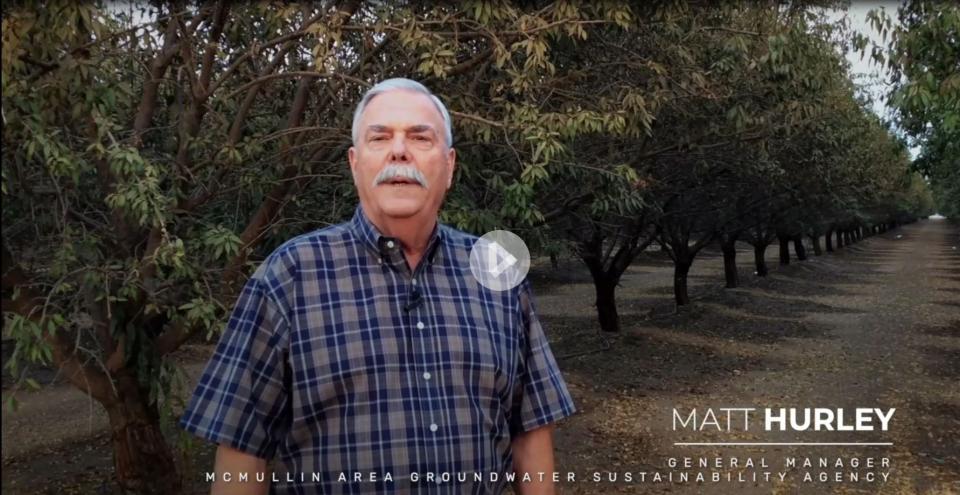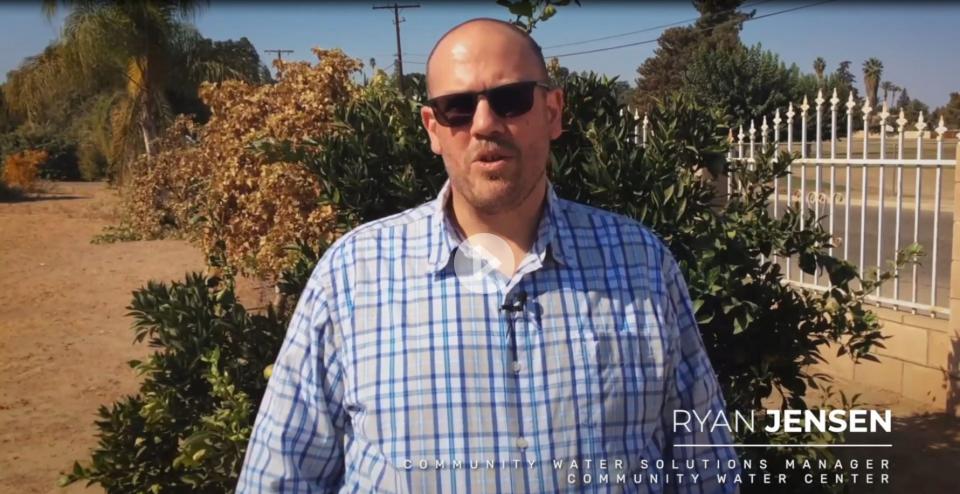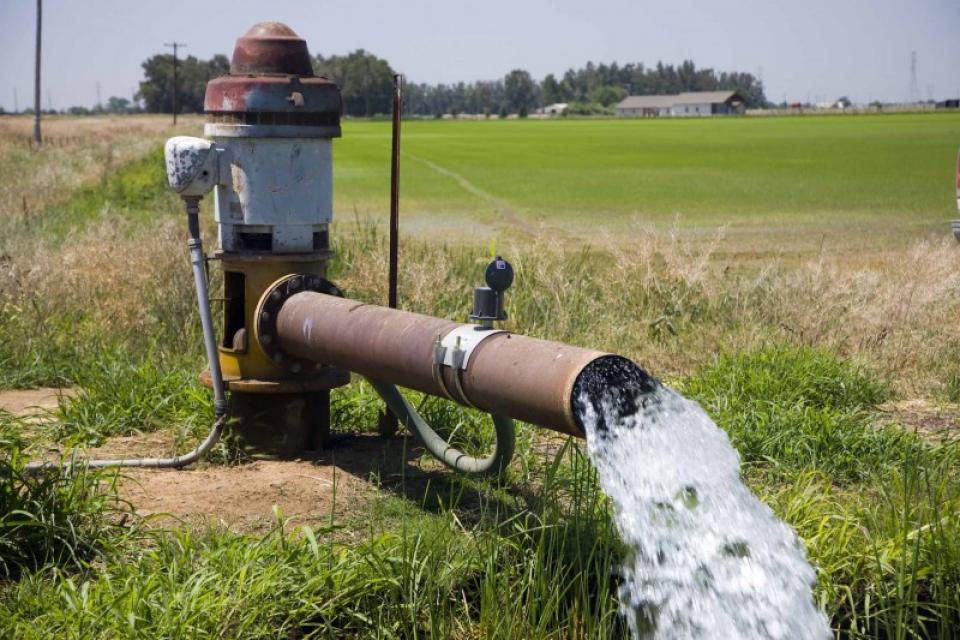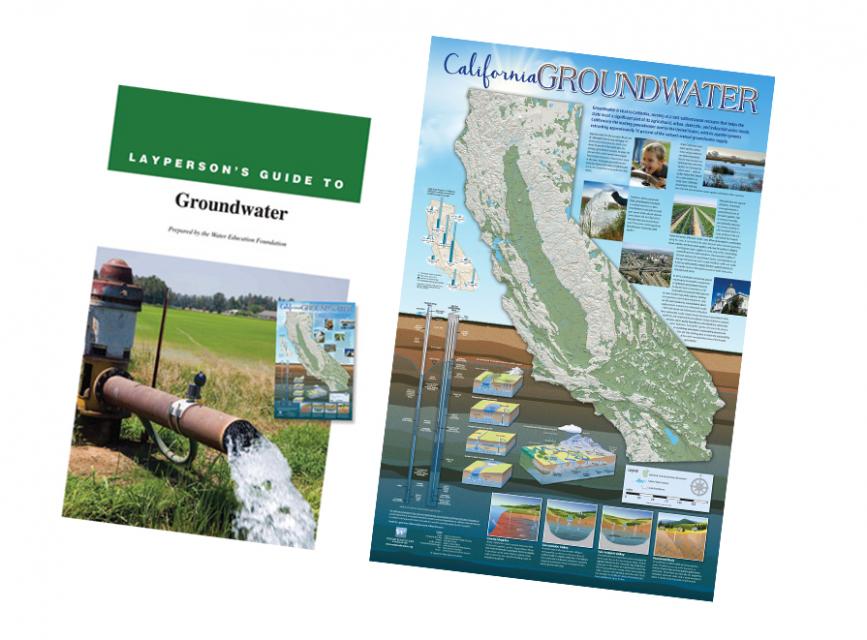In the Heart of the San Joaquin Valley, Two Groundwater Sustainability Agencies Try to Find Their Balance
WESTERN WATER SPECIAL REPORT: Agencies in Fresno, Tulare counties pursue different approaches to address overdraft and meet requirements of California’s groundwater law
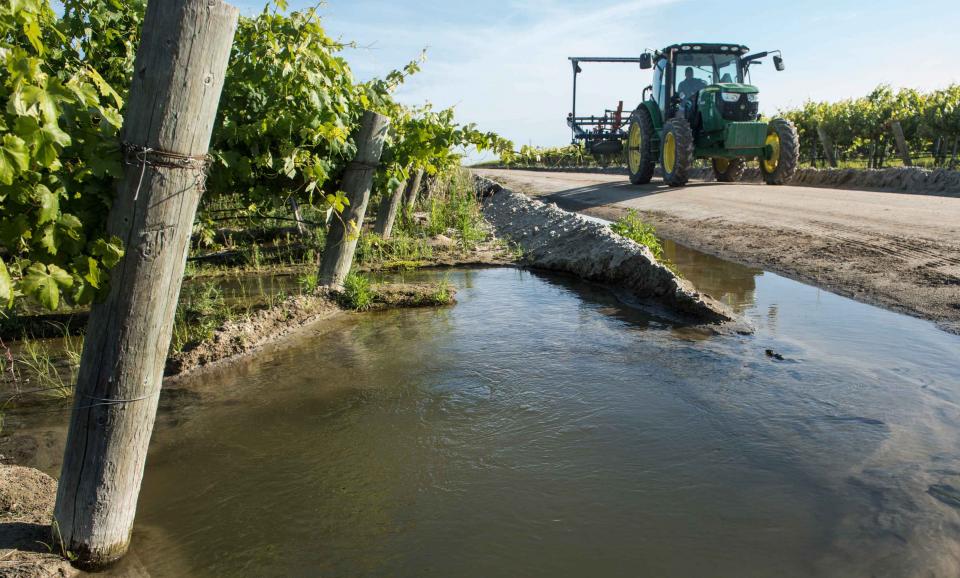 Across a sprawling corner of southern Tulare County snug against the Sierra Nevada, a bounty of navel oranges, grapes, pistachios, hay and other crops sprout from the loam and clay of the San Joaquin Valley. Groundwater helps keep these orchards, vineyards and fields vibrant and supports a multibillion-dollar agricultural economy across the valley. But that bounty has come at a price. Overpumping of groundwater has depleted aquifers, dried up household wells and degraded ecosystems. The land is literally sinking, throttling the Friant-Kern Canal, a major artery that bisects the area on its way to bringing much-needed water south to farms and communities in Kern County.
Across a sprawling corner of southern Tulare County snug against the Sierra Nevada, a bounty of navel oranges, grapes, pistachios, hay and other crops sprout from the loam and clay of the San Joaquin Valley. Groundwater helps keep these orchards, vineyards and fields vibrant and supports a multibillion-dollar agricultural economy across the valley. But that bounty has come at a price. Overpumping of groundwater has depleted aquifers, dried up household wells and degraded ecosystems. The land is literally sinking, throttling the Friant-Kern Canal, a major artery that bisects the area on its way to bringing much-needed water south to farms and communities in Kern County.
Against this backdrop, the Eastern Tule Groundwater Sustainability Agency (GSA) has the urgent challenge of bringing its groundwater basin into balance within the next 20 years. It’s an epic task: reduce pumping by the growers whose products fill the nation’s grocery aisles and are exported globally, and protect the more than 800 domestic wells within Eastern Tule’s boundaries.
“We are trying to keep enough flexibility so that you make the decision economically whether you continue farming or not.”
~Eric Borba, Tulare County dairyman and chair of Eastern Tule GSA.
“We know there is going to be a lot of property going out [of production] because there is not enough water for every acre to be farmed,” said Eric Borba, a dairy operator in Tulare County who chairs the Eastern Tule GSA. “We are trying to keep enough flexibility so that you make the decision economically whether you continue farming or not.”
About 80 miles up Highway 99 to the northwest, in an area straddling the verdant center of Fresno County, the McMullin Area Groundwater Sustainability Agency is facing its own set of challenges in trying to balance groundwater use with its available supply – and seeing opportunities.
The land in McMullin is conducive to growing just about anything the market wants, but much of what grows there are acres upon acres of grapes and almonds. Unlike the Eastern Tulare GSA, McMullin is almost entirely dependent on groundwater – it has no surface water rights – and those groundwater levels have been dropping for decades.
EDITOR’S NOTE: Special Groundwater Project Marks Three Years for Online Magazine
It’s been three years since we took Western Water magazine to an online platform to increase the accessibility of our articles that examine developments in the science, management and law of our most vital natural resource in California and the West. The magazine has been a trusted source on water issues since 1977. Our latest offering is this special report on groundwater. Read the full Editor’s Note from Jenn Bowles.
“We are a desert within the tropical oasis, as far as surface water supply,” said Matt Hurley, general manager of the McMullin Area GSA.
McMullin and Eastern Tule offer an up-close look at how two of the San Joaquin Valley’s more than 40 groundwater sustainability agencies are trying to meet the requirements of California’s Sustainable Groundwater Management Act (SGMA). After decades of pumping, the valley’s basins are significantly depleted, and local agencies, whose boards in many cases are comprised of the growers themselves, are on the hook for making things right.
Like their neighbors, McMullin and Eastern Tule anticipate a future with less groundwater pumping. At the same time, they’re counting on capturing any extra surface water (including flood flows) for their respective basins to remain economically vibrant. While they are pursuing different approaches to achieve sustainability and must wrestle with different challenges, both know that decades of pumping too much water from the ground must end.
‘A Monumental Step’
In 2014, California became the last state in the West to take on groundwater oversight through SGMA. The law requires critically overdrafted basins — mostly in the San Joaquin Valley, home to a $36 billion farm economy — to achieve groundwater sustainability by 2040. To attack the problem, the law required regions across the state to form groundwater sustainability agencies like Eastern Tule and McMullin. A year ago, those agencies overseeing the most critically overdrafted basins submitted groundwater sustainability plans (GSPs) to the state that describe how their basins will achieve balance.
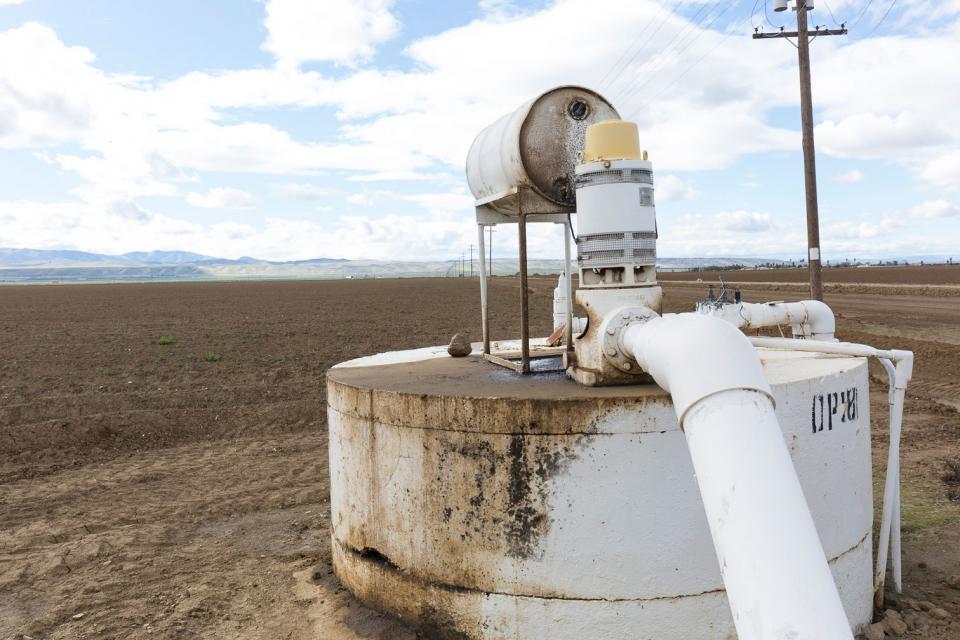 Forty-three plans representing 18 of the valley’s most critically overdrafted groundwater basins – including those from the Eastern Tule and McMullin GSAs – are in the hands of the California Department of Water Resources (DWR) for review. Getting them there “was a monumental step” because it showed what local jurisdictions are looking at over the course of the next 20 years, said Ryan Jacobsen, chief executive officer of the Fresno County Farm Bureau.
Forty-three plans representing 18 of the valley’s most critically overdrafted groundwater basins – including those from the Eastern Tule and McMullin GSAs – are in the hands of the California Department of Water Resources (DWR) for review. Getting them there “was a monumental step” because it showed what local jurisdictions are looking at over the course of the next 20 years, said Ryan Jacobsen, chief executive officer of the Fresno County Farm Bureau.
Ellen Hanak, director of the Public Policy Institute of California’s Water Policy Center, said the next five years will show how well the plans are going to set up areas for success. “They don’t need to solve everything overnight,” she said, “but they will need to show progress.”
SGMA is historic and unprecedented – more than 250 new local agencies were set up across California covering different portions of 140 groundwater basins. It’s been an extensive process of mapping basins, estimating supplies and drafting allocation strategies. And it has not been easy.
EXPLAINER: The Sustainable Groundwater Management Act: The Law, The Judge And The Enforcer
Groundwater provides about 40 percent of the water in California for urban, rural and agricultural needs in typical years, and as much as 60 percent in dry years when surface water supplies are low. But in many areas of the state, groundwater is being extracted faster than it can be replenished. In 2014, amid a deep drought, the state Legislature adopted the Sustainable Groundwater Management Act (SGMA), making California the last Western state to regulate groundwater. Learn more about the law and how it works.
“This is the equivalent of building a Boeing 747 jet and you are flying it at the same time as you are trying to build it,” said Tricia Stever Blattler, executive director of the Tulare County Farm Bureau.
Among the concerns across the San Joaquin Valley is how much farmland will have to be taken out of production because there isn’t the water to support it. The PPIC, for example, projected that farming could end on at least 500,000 acres valleywide. A pair of economists from the University of California, Berkeley, David Sunding and David Roland-Holst, estimated the impact could be double that – as much as 1 million acres, or 20 percent of all cultivated acreage in the valley. SGMA’s economic impact, they said, could be concentrated in the valley’s southernmost and most agriculturally productive counties: Fresno (home to the McMullin Area GSA), Tulare (where Eastern Tule is located), Kern and Kings counties.
“This is the equivalent of building a Boeing 747 jet and you are flying it at the same time as you are trying to build it.”
~Tricia Stever Blattler, executive director of the Tulare County Farm Bureau
“We know we can fix part of the issue so hopefully we don’t see a million-plus acres go out, but the fact is at some point, somewhere, there is likely acreage that’s fallowed and we are trying to do everything we can to minimize that number,” Jacobsen said.
The sustainability plans are a work in progress. In some cases, they have been criticized for underestimating overdraft (the amount of groundwater pumped and not replenished) and overestimating available water to recharge the aquifers. Nongovernmental organizations say nearly all of the plans do not adequately protect domestic wells or groundwater-dependent ecosystems.
All eyes are now on DWR to see how it evaluates submitted plans and how it’s going to handle the response by agencies in the state’s less critically overdrafted basins, which must submit their plans by next year. DWR’s evaluation is predicated on the belief that sustainability can be achieved in a variety of ways using a variety of methods.
“While the path to sustainability may vary, the outcome is clear that measurable progress needs to be made over the SGMA timeline,” said Steven Springhorn, acting deputy director of DWR’s Sustainable Groundwater Management Office. “The law has this initial step of submitting the plans but that is the beginning of the journey, not the end.”
SIDEBAR: Groundwater Management Requirements Spark Innovative Approaches to Reach Sustainability
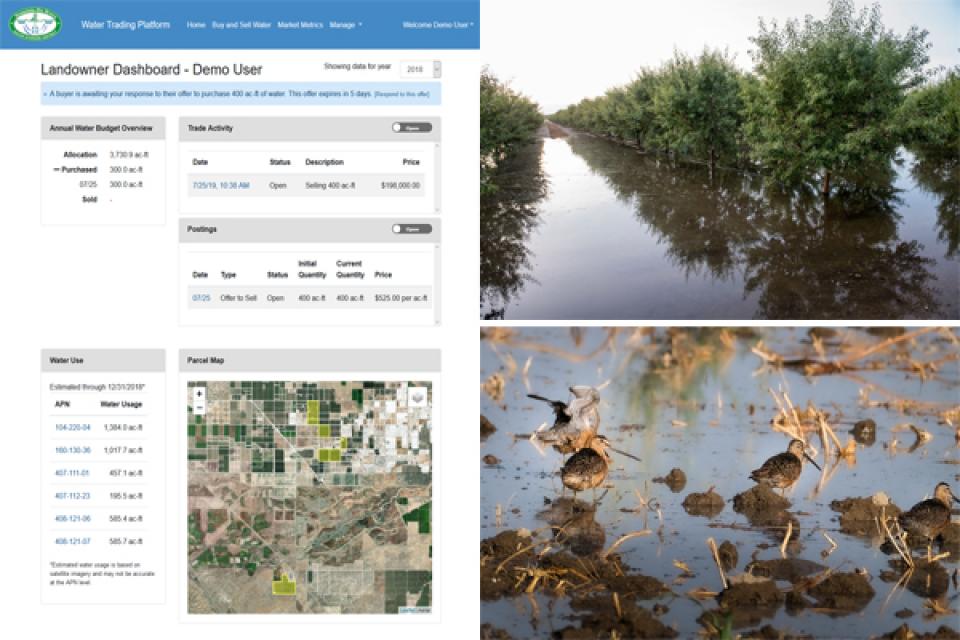 The San Joaquin Valley is in a big hole in reaching groundwater sustainability. Driven by the need to keep using water and comply with California’s Sustainable Groundwater Management Act, people throughout the valley are looking for innovative and cost-effective ways to manage and use groundwater more wisely. Explore three examples of innovation here.
The San Joaquin Valley is in a big hole in reaching groundwater sustainability. Driven by the need to keep using water and comply with California’s Sustainable Groundwater Management Act, people throughout the valley are looking for innovative and cost-effective ways to manage and use groundwater more wisely. Explore three examples of innovation here.
DWR is expected to release determinations on some of the plans in the first half of this year. “None of them coming in the door are perfect and that’s not a surprise,” DWR Director Karla Nemeth said at PPIC’s November 2020 conference on water resiliency. “There will be a lot of opportunities to iterate what’s working and not working.”
Still, once the plans were filed, and even though they were under review by the state, they took effect. The clock is ticking on achieving sustainability.
 “We are seeing GSAs now working on implementation of the plans,” said David Orth, a water resource consultant who helped draft SGMA. “None of the overdrafted basins are sitting on their heels, despite the fact that the state has this two-year review process. They are working on projects and management actions, including defining ramp-down schedules, developing out water supply projects and pricing structures.”
“We are seeing GSAs now working on implementation of the plans,” said David Orth, a water resource consultant who helped draft SGMA. “None of the overdrafted basins are sitting on their heels, despite the fact that the state has this two-year review process. They are working on projects and management actions, including defining ramp-down schedules, developing out water supply projects and pricing structures.”
Many San Joaquin Valley farmers are not thrilled with the law and fear its consequences for the region’s farm economy. But they know they have no choice but to make it work.
“For the most part, folks out here didn’t agree with SGMA in general, but the majority of them understood this was coming,” said Rogelio Caudillo, general manager of the Eastern Tule GSA.
McMullin: Chipping Away at a Deficit
The San Joaquin Valley is one of the most productive growing regions anywhere but its average annual rainfall, about 15 inches per year, necessitates a reliance on irrigation during the growing season. That water comes from local or imported surface water or groundwater. There’s plenty of land to grow crops, but not enough water to sustain it all.
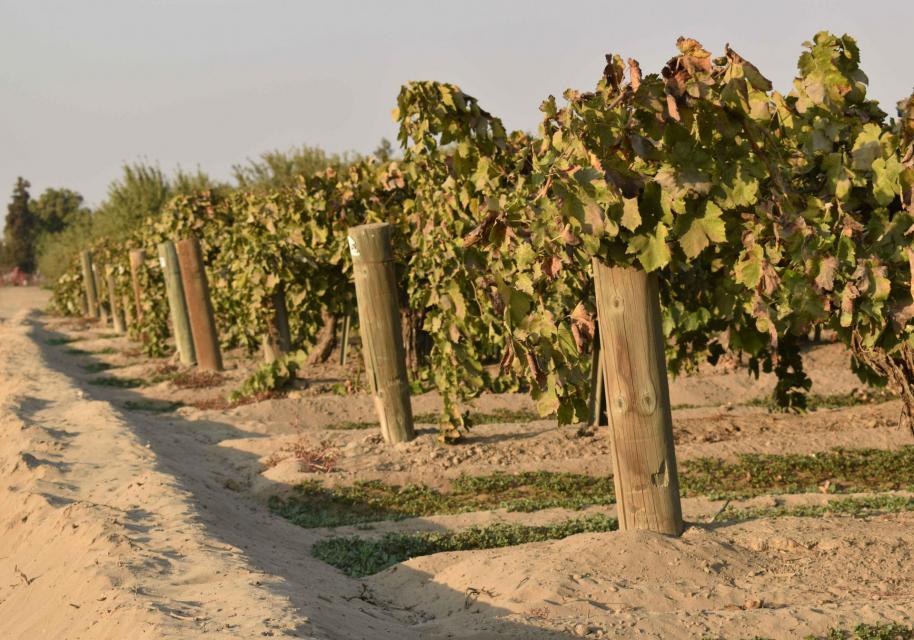 SGMA was written for areas such as McMullin, which is bordered on the north by the San Joaquin River but has no broad rights to the water and no means to move it if rights existed. Thus, the region is entirely dependent on wells to pull up groundwater to irrigate thousands of acres of grapes, almonds, pistachios, grains and field crops.
SGMA was written for areas such as McMullin, which is bordered on the north by the San Joaquin River but has no broad rights to the water and no means to move it if rights existed. Thus, the region is entirely dependent on wells to pull up groundwater to irrigate thousands of acres of grapes, almonds, pistachios, grains and field crops.
“We realized that this region has relied entirely on groundwater for years and I think the growers felt that would never end,” said Don Cameron, vice president and general manager of Terranova Ranch, about 25 miles southwest of Fresno. “We’ve also seen that groundwater levels have dropped continuously over the 40 years that I’ve been farming. We know we have to do something.”
McMullin shares the Kings Groundwater Subbasin in Fresno County with six other sustainability agencies, which must deal with about 120,000 acre-feet of annual overdraft. The majority of that is McMullin’s responsibility to solve. Job one is getting a handle on water use through a metering and monitoring program. That takes time, but the aim is to keep land in production. “We are looking for balance,” said Hurley, McMullin’s general manager. “We are looking for the least amount of acreage to be lost in the process.”
McMullin’s plan hinges on getting growers to collectively reduce their pumping at increments that, after 10 years, will shave about 27,000 acre-feet from the annual overdraft. It’s a tight proposition given McMullin’s groundwater dependence. The plan, adopted in late 2019, aims to meter as many as 900 wells in the next few years to monitor groundwater use and allow for managing groundwater allocations.
McMullin’s groundwater overdraft is dealt with by a schedule of gradual reductions that grow into steeper cuts as 2040 approaches. The final 10 years – the second decade of SGMA compliance – will be crucial. Hurley said the expected reductions in groundwater use are steep, and how much farmland must be retired will depend on how successful the agency’s first decade has been at reducing overdraft.
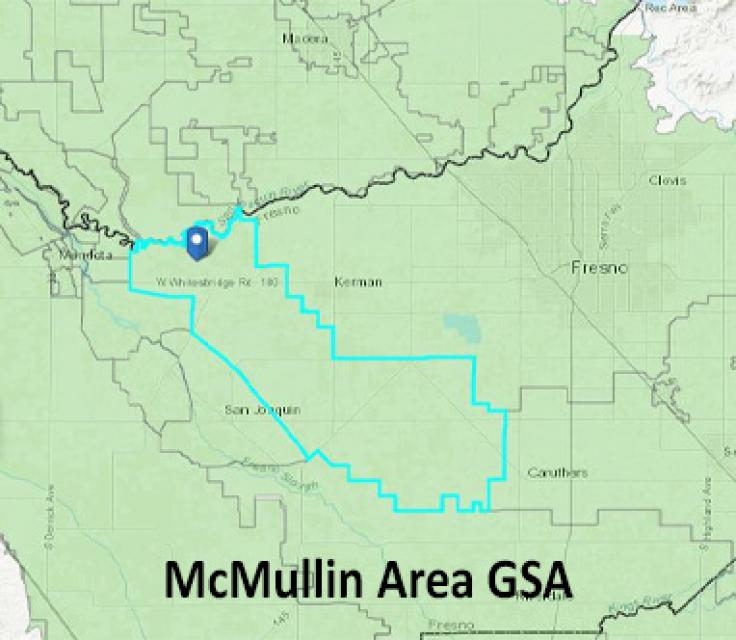 More efficient farming practices and different crop selections make the task more manageable. “Cropping patterns have changed,” said Michael Naito, who grows grapes, almonds and pistachios in the area. “Forty years ago, pretty much all of this area was alfalfa and cotton that was all flood irrigated.” Now, many crops are watered with drip and micro irrigation systems.
More efficient farming practices and different crop selections make the task more manageable. “Cropping patterns have changed,” said Michael Naito, who grows grapes, almonds and pistachios in the area. “Forty years ago, pretty much all of this area was alfalfa and cotton that was all flood irrigated.” Now, many crops are watered with drip and micro irrigation systems.
Meeting SGMA’s 20-year timeline to achieve sustainability by 2040 means taking steps now to find money through grants and partnerships to build the canals, pipelines and other water infrastructure necessary to move and bank water in the aquifer.
“If we wanted to buy water right now, we couldn’t move it because we really don’t have any improvements,” said Hurley. “I’ve got to get a main conveyance system built during this first 10 years and do some things to prepare for the ability to buy water when it’s available and when we can afford it.”
A key element of McMullin’s plan is to develop a groundwater bank within its boundaries that outside partners will want to join to store surplus water when it is available. McMullin believes its plan will be attractive to potential partners because McMullin sits over a deep basin where ample water can be stored. Under McMullin’s concept, when the partners take back their banked water, they would leave some behind for McMullin’s use.
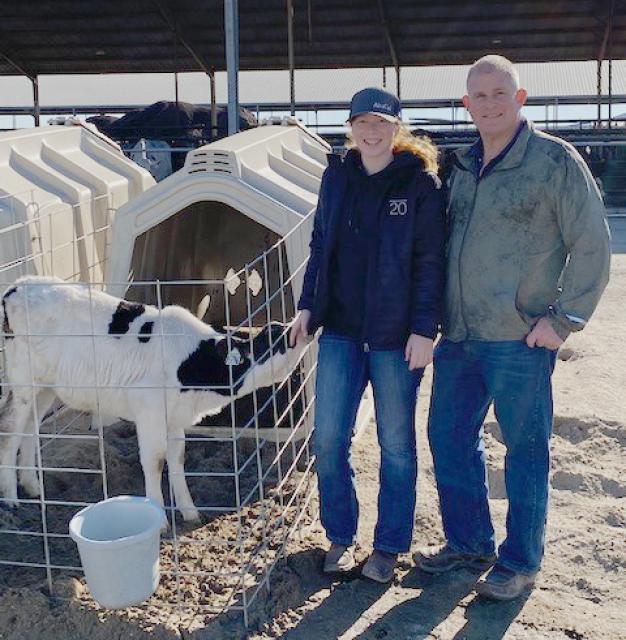 “The capacity is estimated to be substantial,” Hurley said. “The possibilities that a water bank provides are many, and a SGMA solution for us is greatly enhanced by a bank.”
“The capacity is estimated to be substantial,” Hurley said. “The possibilities that a water bank provides are many, and a SGMA solution for us is greatly enhanced by a bank.”
Steve Shehadey, who farms about 7,500 milk cows and feed stock on more than 5,000 acres in the McMullin Area GSA just south of the San Joaquin River, said SGMA is moving him and others to be smarter with their water use through better technology. “The number one question is how much are we using and how can we be more efficient,” he said.
Shehadey, whose groundwater levels benefit from the natural recharge he gets from the river, said everyone has to pull together to help meets the goals of McMullin’s sustainability plan regardless of their groundwater situation. “Whether or not you have good water on your property, we are in the same GSA as other people who may not be as fortunate.”
Eastern Tule GSA: Looking for Balance
Eastern Tule GSA, nestled in a southern corner of Tulare County, includes small farming communities like Terra Bella, an unincorporated town of about 3,300, and the city of Porterville, with nearly 60,000 residents. East Porterville, an impoverished neighborhood just outside the city, gained notoriety during the 2012 to 2016 drought as the face of a community in crisis with depleted drinking water wells. More than half of the land within the Eastern Tule GSA’s boundaries does not receive water as part of an irrigation district or community water system.
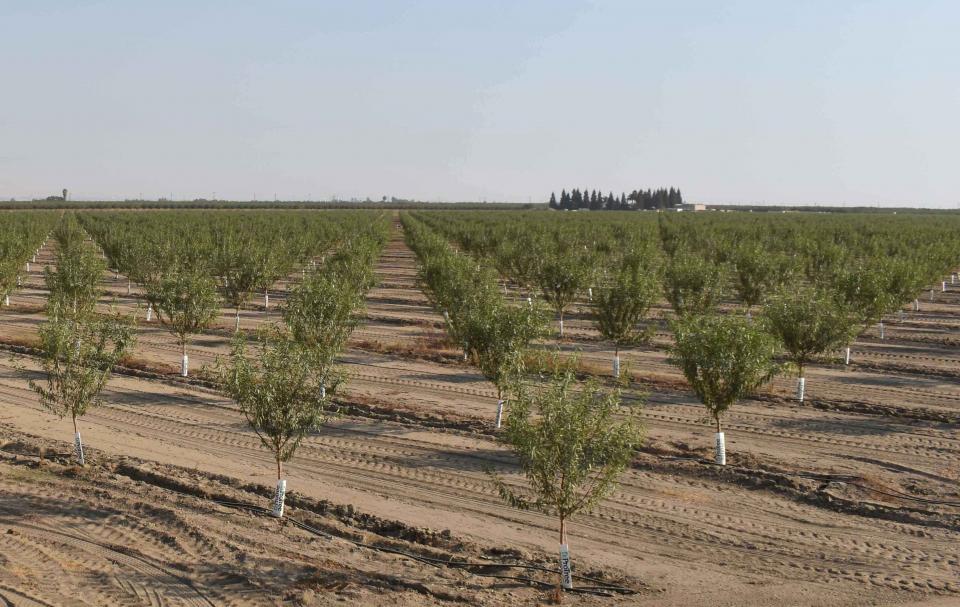 Like McMullin, the Tule Subbasin’s reliance on groundwater has caused overdraft of about 115,300 acre-feet per year. Eastern Tule GSA accounts for just over half of that, or about 61,000 acre-feet per year. While Eastern Tule’s groundwater deficit fares better than McMullin, it still faces several critical issues on the road to sustainability, among them slowing subsidence of the Friant-Kern Canal and ensuring pumping doesn’t impair groundwater wells in small, rural communities, all of which are considered disadvantaged or severely disadvantaged because of meager household incomes.
Like McMullin, the Tule Subbasin’s reliance on groundwater has caused overdraft of about 115,300 acre-feet per year. Eastern Tule GSA accounts for just over half of that, or about 61,000 acre-feet per year. While Eastern Tule’s groundwater deficit fares better than McMullin, it still faces several critical issues on the road to sustainability, among them slowing subsidence of the Friant-Kern Canal and ensuring pumping doesn’t impair groundwater wells in small, rural communities, all of which are considered disadvantaged or severely disadvantaged because of meager household incomes.
The plan is to develop water budgets for landowners and adopt penalty fees for transitional pumping – amounts taken beyond safe yield. The penalty fees, which start at $245 an acre-foot and rise as more water is used, are meant to discourage overpumping, said Caudillo, Eastern Tule’s general manager.
It’s a tough go in an area dominated by agriculture, said Tulare County Supervisor Dennis Townsend, an Eastern Tule GSA board member and Porterville native. “Every decision you are making is impacting your friends and neighbors and yourself.”
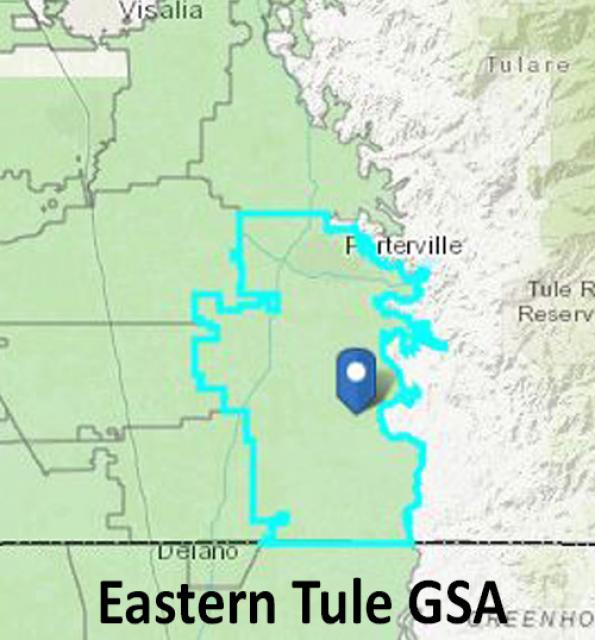 Caudillo acknowledged SGMA will put a dent in the area’s farming enterprise. “We are trying to find a solution that achieves sustainability, without putting people out of business so there is at least a future for those who can make it happen.”
Caudillo acknowledged SGMA will put a dent in the area’s farming enterprise. “We are trying to find a solution that achieves sustainability, without putting people out of business so there is at least a future for those who can make it happen.”
Steve Kisling, an almond grower who serves as vice chair of the Eastern Tule GSA, said requirements to ramp down pumping begin gradually during the first 10 years, then at a more aggressive pace after that. Like McMullin, the approach gives growers a transition period with the caveat that more aggressive actions can be taken should water levels drop faster than expected.
Eastern Tule is counting on an increased surface water supply from the Tule River Spillway Enlargement Project at Success Lake, a reservoir east of Porterville, to help recharge its depleted aquifer. When completed in 2023 the expansion project will allow the reservoir to capture more snowmelt from the Sierra Nevada and storm runoff, reducing the downstream risk of flooding while also increasing by 25 percent the reservoir’s ability to retain water for dry periods and recharging aquifers.
Townsend, who has been involved with the Army Corps of Engineers project as a county supervisor and flood control district board member, said the extra storage will help officials to “smooth out the curve” of drought and not have to dump water when conditions are wet.
“We can release that water over a longer period of time,” he said, adding that the land downstream of the lake is sandy and loamy — perfect for groundwater recharge.
Eastern Tule: Saving the Friant-Kern Canal
While the San Joaquin Valley relies heavily on groundwater, it is crisscrossed with aqueducts, canals and pipes that import water from Northern California and elsewhere to sustain farmers and cities. On the valley’s east side, the 70-year-old Friant-Kern Canal delivers clean, snowmelt-fed water from the Sierra Nevada above Fresno that makes orchards explode with a bounty of fruits and nuts. Because of groundwater overdraft around Eastern Tule, the canal is also sagging, constricting its ability to move water by gravity to farms and cities in southern Tulare and Kern counties.
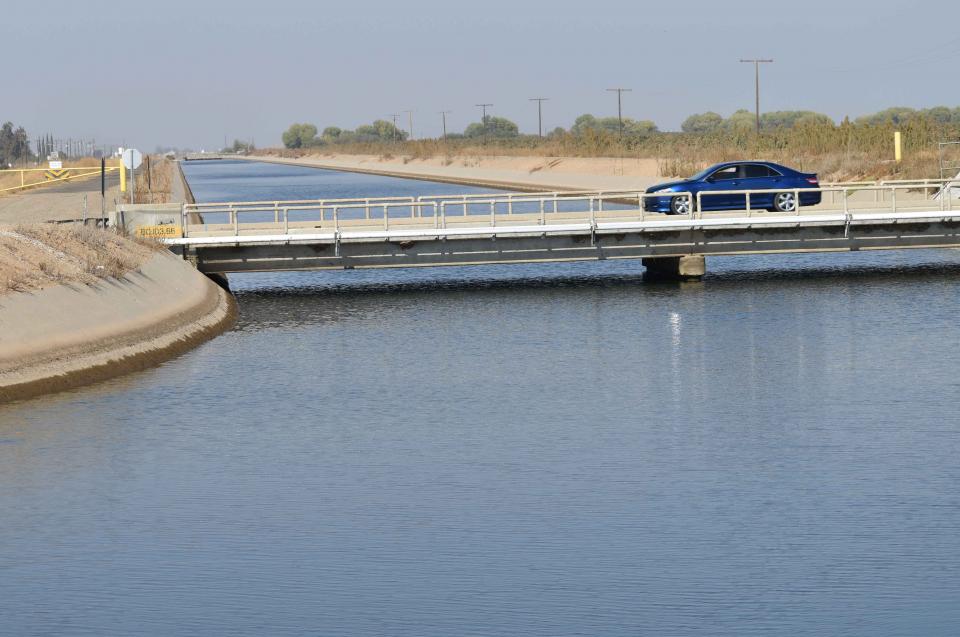 Subsidence affects the canal in a 33-mile stretch from around Porterville south to Delano. Johnny Amaral, chief of external affairs with the Friant Water Authority, said that while subsidence is occurring throughout the valley, it is particularly acute through the Eastern Tule GSA region. Ten water contractors between Porterville and Arvin in Kern County are losing water that the canal can’t deliver, he said.
Subsidence affects the canal in a 33-mile stretch from around Porterville south to Delano. Johnny Amaral, chief of external affairs with the Friant Water Authority, said that while subsidence is occurring throughout the valley, it is particularly acute through the Eastern Tule GSA region. Ten water contractors between Porterville and Arvin in Kern County are losing water that the canal can’t deliver, he said.
And therein lies the problem. Groundwater pumping can’t come to a complete halt in the Eastern Tule region, but virtually any rate of pumping affects the canal. Eastern Tule’s 20-year plan projects another three feet of subsidence to the canal as it tries to gradually reduce overpumping. It also proposes a land subsidence management zone at the sag in the canal. Balancing pumping and subsidence effects is the goal.
Finding a solution to the problem takes coordination and patience. In December, the two agencies announced an agreement in which Friant Water Authority will support Eastern Tule’s sustainability plan in exchange for up to $200 million from Eastern Tule to fund repairs to the Friant-Kern Canal.
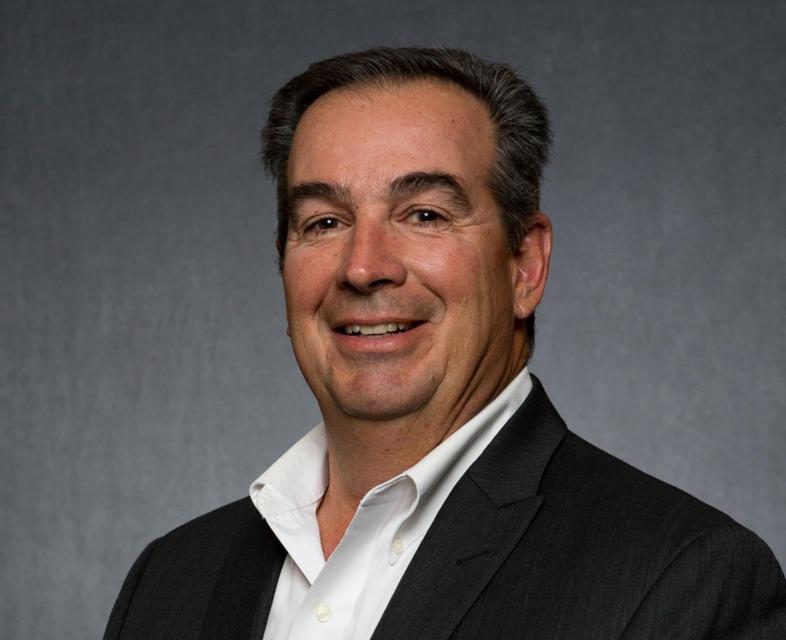 Amaral, with the Friant Water Authority, said his agency is sympathetic to Eastern Tule’s challenge, recognizing that the groundwater sustainability plan anticipates subsidence will continue to occur on lands immediately adjacent to the canal.
Amaral, with the Friant Water Authority, said his agency is sympathetic to Eastern Tule’s challenge, recognizing that the groundwater sustainability plan anticipates subsidence will continue to occur on lands immediately adjacent to the canal.
“I know some people say, ‘really?’ but we think it’s appropriate and reasonable that they be able to implement the plan,” Amaral said. “But at the same time [we] recognize their plan is going to cause damage to the canal and deliveries in the future.”
Borba, the dairyman who sits on both the Eastern Tule and Friant Water Authority boards, said the canal’s role is vital because the water it delivers helps maintain a higher water table and better water quality. That, in turn, helps people who rely on small wells for their household needs, he said, especially those living in disadvantaged communities.
Preserving Drinking Water Where It Counts
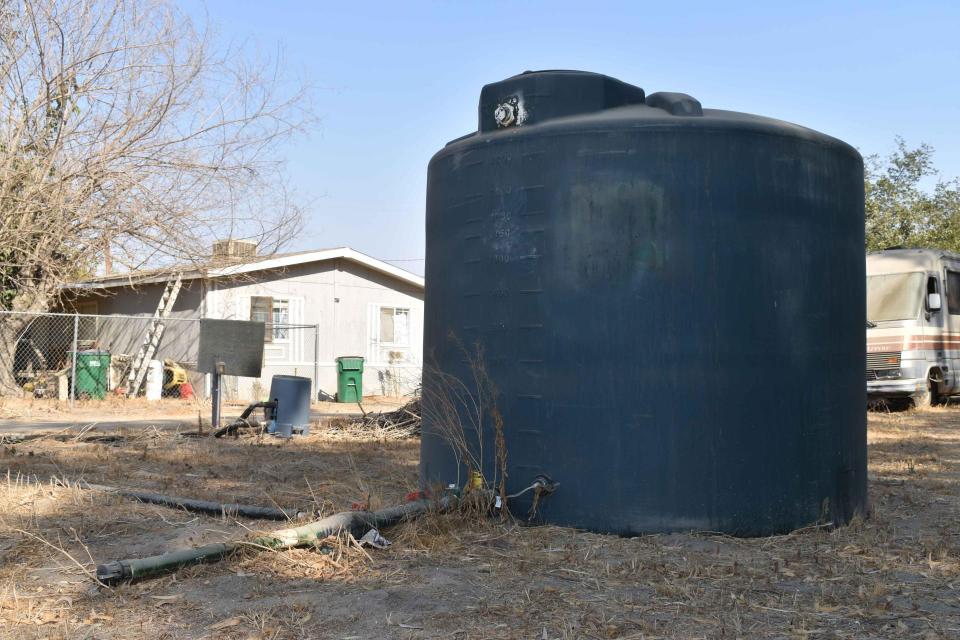 A key aim of SGMA is ensuring the survival of wells that people in small communities, many of them economically disadvantaged, rely on for their daily needs. Drought and overdraft have rendered many valley wells useless. Built to shallow depths, they are unable to reach the groundwater as it drops in the aquifer. Most of these communities are not connected to neighboring water systems and are forced to rely on trucked-in supplies when their wells dry up, which is what occurred in 2015 at East Porterville.
A key aim of SGMA is ensuring the survival of wells that people in small communities, many of them economically disadvantaged, rely on for their daily needs. Drought and overdraft have rendered many valley wells useless. Built to shallow depths, they are unable to reach the groundwater as it drops in the aquifer. Most of these communities are not connected to neighboring water systems and are forced to rely on trucked-in supplies when their wells dry up, which is what occurred in 2015 at East Porterville.
SGMA requires GSAs like McMullin and Eastern Tule to consider drinking water wells, but there is concern that withdrawals by large users will come at the expense of the small, individual wells.
Justine Massey, policy advocate with Community Water Center, a Visalia-based advocacy group, said drinking water concerns have not been given their due in many valley groundwater sustainability plans.
“There is substantial data missing on how communities will be impacted and they don’t have a plan for how to get it,” she said. “This is dangerous. It’s like driving blind and hoping nothing bad happens.”
A report released in 2020 by the Water Foundation, a policy and advocacy organization based in Sacramento, notes that pumping contemplated in sustainability plans throughout the valley could leave as many as 12,000 drinking water wells partially or completely dry by 2040, leaving as many as 127,000 people without their primary source of water and costing hundreds of millions of dollars to repair. (The Water Foundation is not affiliated with the Water Education Foundation.)
Eastern Tule’s sustainability plan acknowledges the difficulties ahead, noting that increased costs of obtaining supplemental water and conservation programs could hit disadvantaged communities disproportionately. In response, Eastern Tule plans to protect drinking water wells the same way it minimizes subsidence, through targeted monitoring and metering.
 Trees and crops vastly outnumber people in the McMullin Area GSA, which encompasses only one tiny community, Raisin City, with fewer than 400 residents, and a smattering of small clusters of homes. McMullin’s sustainability plan notes that two clusters of homes were identified as disadvantaged, and it got help from Fresno State’s California Water Institute to knock on doors and solicit residents’ comments on its sustainability plan. McMullin said it doesn’t anticipate any of those domestic wells going dry.
Trees and crops vastly outnumber people in the McMullin Area GSA, which encompasses only one tiny community, Raisin City, with fewer than 400 residents, and a smattering of small clusters of homes. McMullin’s sustainability plan notes that two clusters of homes were identified as disadvantaged, and it got help from Fresno State’s California Water Institute to knock on doors and solicit residents’ comments on its sustainability plan. McMullin said it doesn’t anticipate any of those domestic wells going dry.
Orth, the water resources consultant, said aligning SGMA with the drinking water challenges to vulnerable communities is not a perfect process. Disadvantaged communities, he said, have long-standing issues with access to safe and reliable water, issues that groundwater sustainability agencies were not set up to deal with.
Furthermore, SGMA does not task GSAs with the authority or responsibility for ensuring drinking water for small communities. “SGMA says sustainable groundwater management should include avoiding significant and unreasonable degradation, not protection, of drinking water quality,” Orth said. “That’s a pretty gray area.”
Massey, with Community Water Center, said GSAs have broad authority to limit pumping, build effective monitoring networks and regulate recharge, all of which affect drinking water quality. “Water quality is part of the SGMA mandate,” she said. “Significant and unreasonable degradation of water quality must be avoided as one of the six undesirable results.”
Massey noted that some GSAs, including Eastern Tule, have committed to reserving domestic and small-user amounts of groundwater before allocating the rest among more heavy-duty users. “Unfortunately,” she said, “it’s not something many GSAs have done.”
SGMA: Only the Beginning
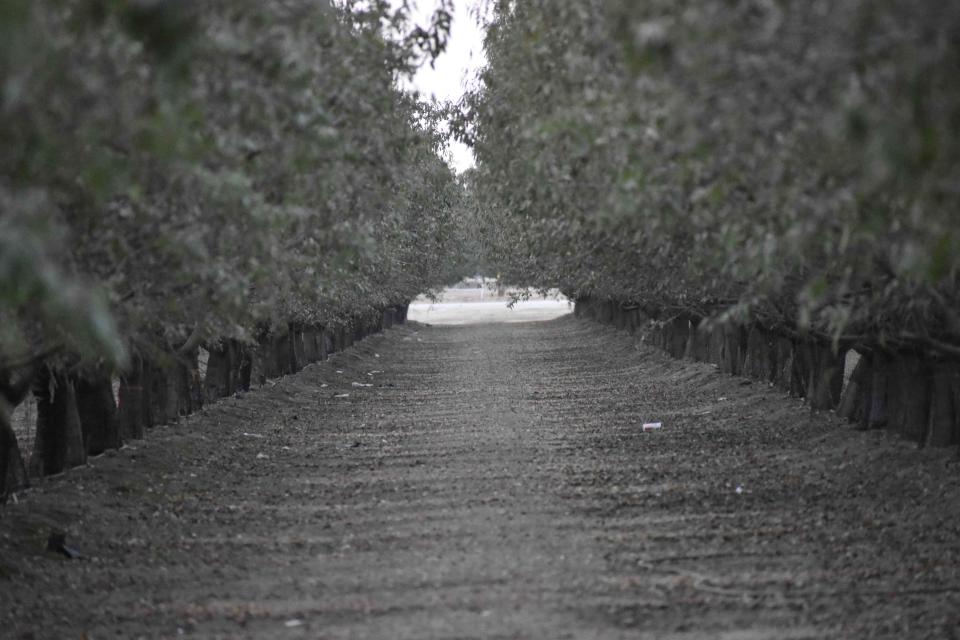 Despite concerns over how SGMA will affect the San Joaquin Valley’s multi-billion-dollar farming economy, some farmers in both Eastern Tule and McMullin GSAs acknowledge that the historic unmanaged groundwater use was unsustainable. But bringing groundwater use into balance with what nature and ingenuity can supply will be a learning process that will take time.
Despite concerns over how SGMA will affect the San Joaquin Valley’s multi-billion-dollar farming economy, some farmers in both Eastern Tule and McMullin GSAs acknowledge that the historic unmanaged groundwater use was unsustainable. But bringing groundwater use into balance with what nature and ingenuity can supply will be a learning process that will take time.
Kisling, with Eastern Tule GSA, said SGMA is necessary and probably overdue.
“It would have been much less disruptive if it had gone into effect years earlier and if the implementation [period] had been longer,” he said. “We are trying to create whole agencies that monitor and regulate groundwater pumping, something that hasn’t been regulated before, in just a matter of a few short years.”
Blattler, with the Tulare County Farm Bureau, noted that SGMA is the first step in getting basins on the long road to sustainability. “We are in an ever-adapting and evolving economy where land uses will change, commodity prices and farming costs will continue to be volatile and ownership transitions will occur,” she said. “There will be more competition for those resources in the next 20 years and “it’s not like we are going to have a finite amount of water locked in at a point in time. It is an ever-changing asset to our community that evolves as will the SGMA plans.”
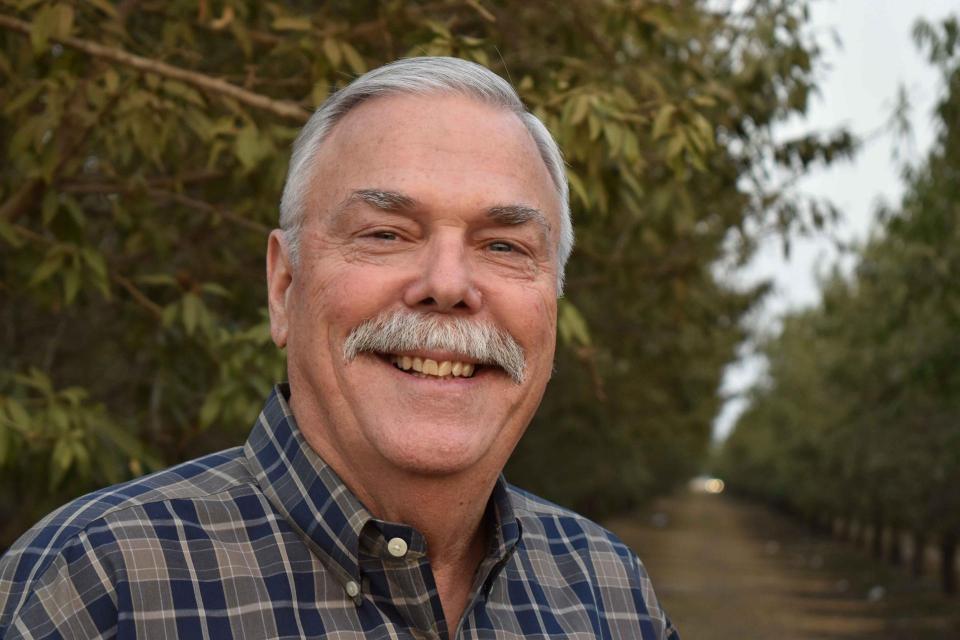 In a way, SGMA corrects for some agricultural development in the San Joaquin Valley that perhaps shouldn’t have occurred, said Hurley, with McMullin GSA.
In a way, SGMA corrects for some agricultural development in the San Joaquin Valley that perhaps shouldn’t have occurred, said Hurley, with McMullin GSA.
“I personally believe that SGMA was – contrary to the many folks who think the government should have stayed out of their business – a timely bit of legislation,” he said. “I don’t think it’s going to be as bad as some have predicted.”
Hurley said SGMA has forced growers to accelerate their effort to be more efficient with their water.
“That is not to say we did anything bad before, but we didn’t have to fine tune it,” Hurley said. “Now, you’ve got to balance the checkbook to the penny in order to make sure everything works correctly. That says nothing about looking backward, it says everything about looking forward. I absolutely believe we will figure this out.”
Comparing McMullin Area GSA and Eastern Tule GSA
Reach Gary Pitzer: gpitzer@watereducation.org, Twitter: @GaryPitzer
Know someone else who wants to stay connected with water in the West? Encourage them to sign up for Western Water, and follow us on Facebook, Twitter and LinkedIn.This article was supported by a grant from The Water Desk, an independent journalism initiative based at the University of Colorado Boulder’s Center for Environmental Journalism.





